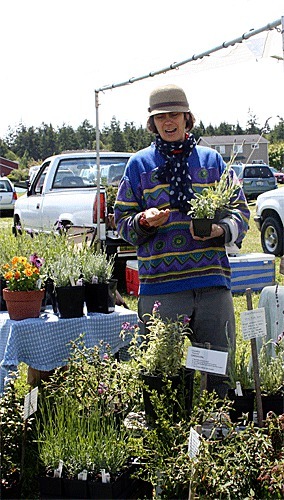Who would have thought February would last for four months?
The cool, dreary, rainy weather that dominates the winter month continued into March, April and May. Those soggy conditions have drenched many Whidbey farm fields, delaying the growing season and when local farmers have crops to sell at local markets.
“Two-thirds of our garden was basically under water,” said Julieanna Purdue of Prairie Bottom Farm located south of Coupeville. “We had a duck and goose habitat out there.”
She said enough of the field has drained to allow for planting of crops, but the farm isn’t providing the same selection available at the market that was available the same time last year.
Fortunately they were able to grow enough produce to start their community-supported agriculture program on schedule. Purdue was selling such produce as radishes and salad greens during the Coupeville Farmer’s Market last Saturday.
Meteorologists have reported that March through May has been the coldest on record in the Puget Sound region.
Numbers indicate that more rain has fallen on Whidbey Island than in recent years. Clark Bishop of Ebey Road Farm compiles rain records from the Washington State University AgWeatherNet project, which has a weather station located at Ebey’s Prairie. The numbers show 11.98 inches of rain fell on Central Whidbey Island in 2011 through May, while only 8.24 inches of rain fell through May 2010; 7.59 inches through May 2009; and 7.78 inches of rain fell through May 2008.
Prairie Bottom Farm isn’t the only local grower struggling with the cool weather.
“At this point, we’re still not able to work certain fields,” said Sheila Case Smith, owner of Case Farms near Oak Harbor. She noted the wet spring did provide good conditions for such cold-weather food produce as broccoli and cabbage.
Valerie Reuther of Rosehip Farm said often the fields would start to dry out, only for more rain to return.
To help products that need more heat to flourish, Case Smith said she is considering installing a hoop house that she purchased several years ago. She is also experimenting with growing more cold-tolerant tomatoes. She is currently selling tomato plants at farmers markets.
Another concern is how the damp weather will affect the farm’s hay production for its 35 to 40 cows. She said she needs at least five days of sun on the grass before it can be cut.
Dorothy Mueller, owner of Bell’s Farm on West Beach Road, said strawberries will ripen around July 1, which is weeks later than in normal years.
“It’s got to get warmer,” Mueller said.
Peg Tennant, who manages farmers markets in Coupeville and Oak Harbor, said the farmers who travel from the east side of the state are dealing with similar problems.
“Crops need heat and sunlight to ripen and we haven’t had that,” said Tennant. “Everything is late because of the sun.”
The farmers markets on Whidbey Island are in full swing despite the drenching that soaked Whidbey Island. Coupeville’s farmers market takes place Saturdays from 10 a.m. to 2 p.m. in the field behind the library.
Oak Harbor’s Public Market is open Thursdays from 4 p.m. to 7 p.m. in the wooded area next to the Oak Harbor Chamber of Commerce off Highway 20.
Farmers markets also take place Sunday at the Greenbank Farm, Saturday at Bayview Corner and Sunday Tilth’s market south of Freeland.
This weekend looks to be a pleasant change from record-setting months of cool, wet weather. Sun is in the forecast with highs in the Puget Sound region topping 70 degrees. For Whidbey Island’s frustrated farmers, it’s about time.



